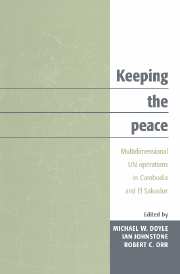Book contents
- Frontmatter
- Contents
- Preface
- Notes on the contributors
- List of abbreviations
- 1 Introduction
- Cambodia
- Map
- 2 Three visions of politics in Cambodia
- 3 The political dynamics of the peacemaking process in Cambodia
- 4 The Cambodian Settlement Agreements
- 5 Holding a fragile peace: the military and civilian components of UNTAC
- 6 Authority and elections in Cambodia
- 7 Returning home: the repatriation of Cambodian refugees
- 8 Quick impacts, slow rehabilitation in Cambodia
- El Salvador
- Conclusion and chronologies
- Select bibliography
- Index
3 - The political dynamics of the peacemaking process in Cambodia
Published online by Cambridge University Press: 22 October 2009
- Frontmatter
- Contents
- Preface
- Notes on the contributors
- List of abbreviations
- 1 Introduction
- Cambodia
- Map
- 2 Three visions of politics in Cambodia
- 3 The political dynamics of the peacemaking process in Cambodia
- 4 The Cambodian Settlement Agreements
- 5 Holding a fragile peace: the military and civilian components of UNTAC
- 6 Authority and elections in Cambodia
- 7 Returning home: the repatriation of Cambodian refugees
- 8 Quick impacts, slow rehabilitation in Cambodia
- El Salvador
- Conclusion and chronologies
- Select bibliography
- Index
Summary
Introduction
After a long and arduous peace process, the negotiations for a political settlement in Cambodia finally culminated in the adoption of the Agreement on a Comprehensive Political Settlement of the Cambodia Conflict in Paris on October 23, 1991. Nineteen nations and the four Cambodian factions gathered to sign a document that would, for the first time in UN history, implement the visions of Secretary-General Boutros-Ghali's “peacebuilding” initiatives, as later outlined in his Agenda for Peace. Unlike the peace process in El Salvador – which was primarily a series of agreements and settlements – the Cambodian conflict was resolved through a series of informal and formal meetings on domestic and international levels, with the Paris Agreement as the multilateral product of a comprehensive set of agreements made during the lengthy peace process. The Cambodian conflict was complicated by geopolitical factors on the factional, regional, and international levels, with such regional and multilateral organizations as the Association of Southeast Asian Nations (ASEAN) and the United Nations (UN) playing a significant role.
The purpose of this chapter is to explore the political dynamics of the peacemaking process that led to the signing of the Paris Agreements in 1991. Placing particular emphasis on the diplomatic initiatives of both the regional actors and the great powers, the chapter will also explore how the ongoing civil war, the history of genocide, and powerful neighbors posed serious obstacles to peace and necessitated a solution which would require the creation of the most ambitious and expensive UN peacekeeping mission in the organization's history.
- Type
- Chapter
- Information
- Keeping the PeaceMultidimensional UN Operations in Cambodia and El Salvador, pp. 53 - 81Publisher: Cambridge University PressPrint publication year: 1997
- 4
- Cited by



